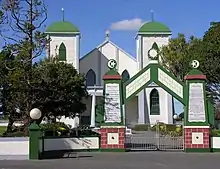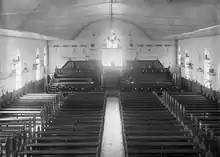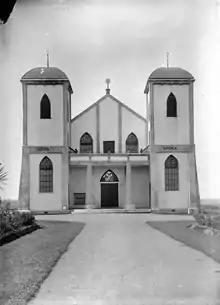Ratana Community
Rātana Pā | |
|---|---|
Town | |
 The temple at Rātana Pā | |
| Coordinates: 40°02′24″S 175°10′40″E / 40.04000°S 175.17778°E | |
| Country | New Zealand |
| Region | Manawatū-Whanganui |
| District | Rangitikei District |
| Wards |
|
| Electorates | |
| Government | |
| • Territorial Authority | Rangitikei District Council |
| • Regional council | Horizons Regional Council |
| Area | |
| • Total | 0.29 km2 (0.11 sq mi) |
| Population (June 2023)[2] | |
| • Total | 390 |
| • Density | 1,300/km2 (3,500/sq mi) |
Rātana Pā, or Ratana Community,[lower-alpha 1] is a town in the North Island of New Zealand, near Whanganui and Marton in the Manawatū-Whanganui region. The locality was the farm of Tahupōtiki Wiremu Rātana, the founder of a Maori religious and political movement, and the settlement developed in the 1920s as followers came to see Rātana. It continues as the centre of the Rātana Church.[4] Due to the importance of the Rātana movement in New Zealand politics, leading New Zealand politicians often attend annual gatherings at Rātana Pā.
Location
Rātana Pā is 20 km south-east of Whanganui, 5 km west of Turakina and 19 km west of Marton. It lies between State Highway 3 and the coast.
History

Rātana Pā is on what was the farm of Tahupōtiki Wiremu Rātana, the founder of the Rātana religious and political movement and the Rātana Church. The locality became a settlement of Rātana followers in the 1920s.
Facilities at Rātana Pā include the 1,000-seat Temepara Tapu o Ihoa (Holy Temple of Jehovah),[4] the Manuao (an accommodation facility and head office of the church), the Whare Māori (which contains crutches and wheelchairs from followers who were healed by Rātana in the 1920s and 1930s) and the Ratana Archives Centre, which contains artefacts and stories from the history of the Rātana Church.
25 January and 8 November are anniversary days of the Rātana Church. On these days thousands of members of the church converge on Rātana Pā for the special anniversary services commemorating the birth of Rātana (25 January 1873) and his first spiritual vision (8 November 1918). The gathering for the birth anniversary lasts for a week, with the highlight being the Temple Service on 25 January. Usually, Members of Parliament (MPs) visit on 24 January to talk and seek the votes of Māori.
Government and politics
Local government
Rātana Pā is in the Southern ward of Rangitikei District, which elects three of the eleven members of the Rangitikei District Council. There is also a Rātana Community Board, one of two community boards in the District (the other being for Taihape).[5] The Board has four elected members and one appointed councillor from the Southern ward.[6]
National government
Rātana Pā, like the rest of the Rangitikei District, is located in the general electorate of Rangitīkei and in the Māori electorate of Te Tai Hauāuru.[7] Rangitīkei is a safe National Party seat since the 1938 election with the exception of 1978–1984 when it was held by Bruce Beetham of the Social Credit Party. Since 2011 it is held by Ian McKelvie.[8]
Te Tai Hauāuru is a more volatile seat, having been held by three different parties since 1996, i.e. New Zealand First, the Māori Party and the Labour Party.[9] Since 2014 it is held by Adrian Rurawhe of the Labour Party.[10]
Demographics
Rātana is defined by Statistics New Zealand as a rural settlement. It covers 0.21 km2 (0.081 sq mi)[1] and had an estimated population of 390 as of June 2023,[2] with a population density of 1,857 people per km2. It is part of the larger Turakina statistical area.[11]
| Year | Pop. | ±% p.a. |
|---|---|---|
| 2001 | 423 | — |
| 2006 | 369 | −2.69% |
| 2013 | 324 | −1.84% |
| 2028 | 345 | +0.42% |
| Source: [3][12] | ||

Ethnicities were 11.3% European/Pākehā, 96.5% Māori, 4.3% Pacific peoples, 0.9% Asian, and 0.9% other ethnicities. People may identify with more than one ethnicity.
Although some people chose not to answer the census's question about religious affiliation, 4.3% had no religion, 6.1% were Christian, and 88.7% had Māori religious beliefs.
Of those at least 15 years old, 33 (11.8%) people had a bachelor's or higher degree, and 78 (28.0%) people had no formal qualifications. 9 people (3.2%) earned over $70,000 compared to 17.2% nationally. The employment status of those at least 15 was that 126 (45.2%) people were employed full-time, 39 (14.0%) were part-time, and 30 (10.8%) were unemployed.[12]
Transport
State Highway 3 ![]() is located 2 km (1.2 mi) to the northeast of Rātana Pā. This national state highway connects Woodville (25 km (16 mi) east of Palmerston North) and Hamilton via New Plymouth.
is located 2 km (1.2 mi) to the northeast of Rātana Pā. This national state highway connects Woodville (25 km (16 mi) east of Palmerston North) and Hamilton via New Plymouth.
InterCity runs three daily and six non-daily services at the Ratana Turn Off stop. These include Palmerston North–Auckland, Wellington–New Plymouth and Auckland–Palmerston North.[13]
The nearest airport is Whanganui Airport, located 22 km (14 mi) to the northwest of the town.
Rātana had a railway station on the Marton–New Plymouth line from 27 April 1898, for goods, and 23 May for passengers. It had a shelter shed, platform, loading bank and a small passing loop. The station closed on 7 December 1947, when the Turakina Deviation diverted the railway away from Rātana.[14] Seven died due to a crash on 26 March 1938, 1 mi 15 ch (1.9 km) from the station,[15] to the north of Lake Waipu.[16]
Education
Te Kura o Ratana is a state-integrated co-educational Rātana Church primary school for Year 1 to 8 students,[17] with a roll of 20 as of April 2023.[18]
The nearest secondary schools are in Whanganui and Marton.
Table footnotes
- ↑ As defined by Statistics New Zealand.[3]
References
- 1 2 "ArcGIS Web Application". statsnz.maps.arcgis.com. Retrieved 9 April 2023.
- 1 2 "Subnational population estimates (RC, SA2), by age and sex, at 30 June 1996-2023 (2023 boundaries)". Statistics New Zealand. Retrieved 25 October 2023. (regional councils); "Subnational population estimates (TA, SA2), by age and sex, at 30 June 1996-2023 (2023 boundaries)". Statistics New Zealand. Retrieved 25 October 2023. (territorial authorities); "Subnational population estimates (urban rural), by age and sex, at 30 June 1996-2023 (2023 boundaries)". Statistics New Zealand. Retrieved 25 October 2023. (urban areas)
- 1 2 "2013 Census QuickStats about a place: Ratana Community". Statistics New Zealand. Retrieved 2 February 2016.
- 1 2 Newman, Keith. "The Founding of a Faith". New Zealand Historic Places Trust. Archived from the original on 12 June 2011. Retrieved 3 August 2019.
- ↑ "Community Boards". Rangitīkei District Council. Retrieved 12 January 2020.
- ↑ "Change to Rangitīkei District Council ward structure from 5 to 3". Rangitīkei District Council. 26 April 2019. Retrieved 12 January 2020.
- ↑ "Find my Electorate". Electoral Commission. Retrieved 1 February 2016.
- ↑ "Rangitīkei Electorate Profile". New Zealand Parliament. 30 September 2012. Retrieved 1 February 2016.
- ↑ "Te Tai Hauāuru Electorate Profile". New Zealand Parliament. 30 September 2012. Retrieved 1 February 2016.
- ↑ "Rurawhe, Adrian". New Zealand Parliament. 4 December 2015. Retrieved 1 February 2016.
- ↑ 2018 Census place summary: Turakina
- 1 2 "Statistical area 1 dataset for 2018 Census". Statistics New Zealand. March 2020. 7017973 and 7017974.
- ↑ "Ratana Turn Off – Bus Timetable". InterCity. 1 February 2016. Retrieved 2 February 2016.
- ↑ Scoble, Juliet. "Station Archive". Rail Heritage Trust of New Zealand.
- ↑ "RATANA RAILWAY SMASH Wanganui Chronicle". paperspast.natlib.govt.nz. 21 July 1938. Retrieved 29 June 2023.
- ↑ "1:63360 map Sheet: N143 Marton". www.mapspast.org.nz. 1942. Retrieved 30 June 2023.
- ↑ "Ministry of Education School Profile". educationcounts.govt.nz. Ministry of Education.
- ↑ "Education Review Office Report". ero.govt.nz. Education Review Office.